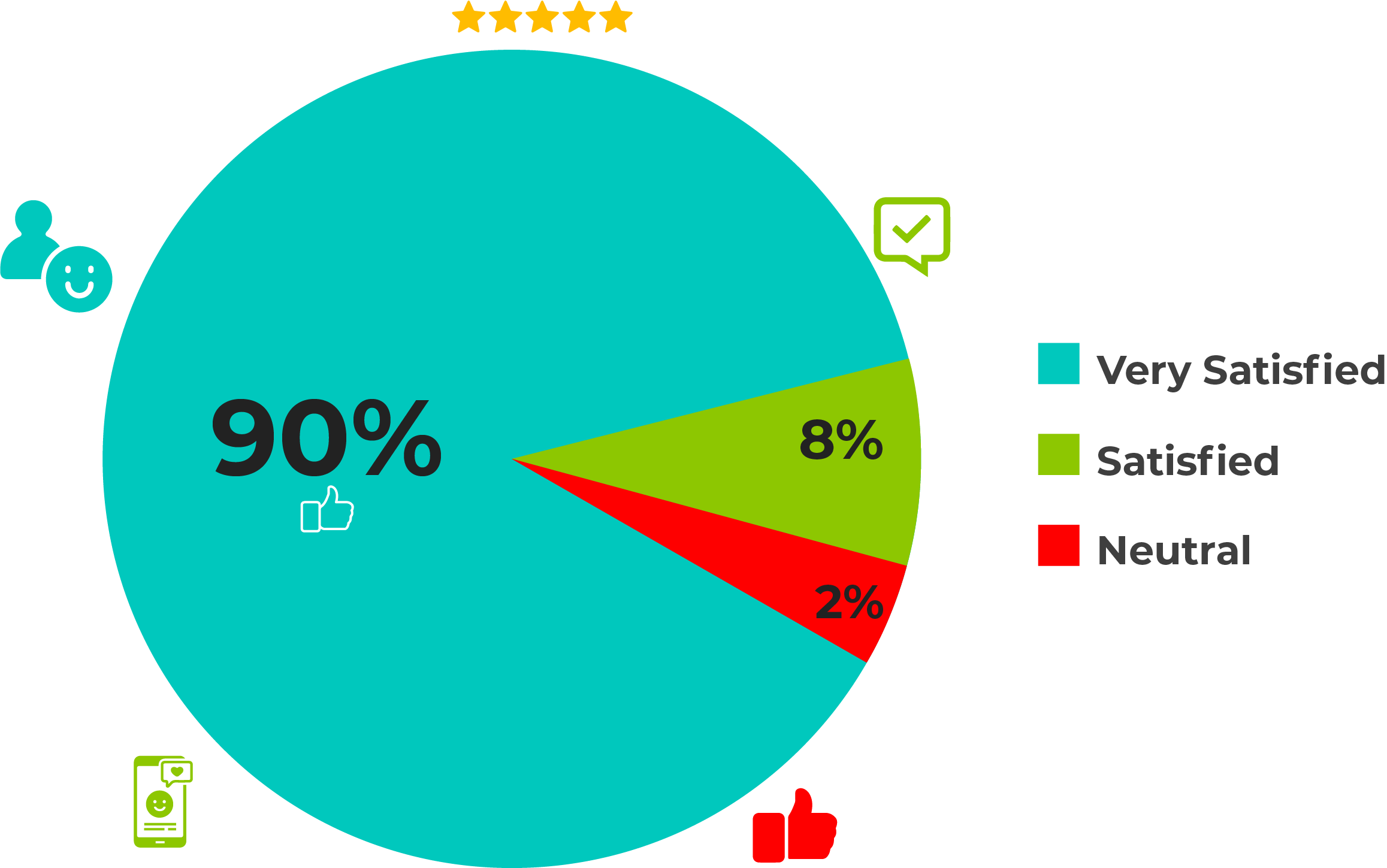What is Customer Satisfaction?
Customer satisfaction is a metric that is used to measure how happy and content a customer is with the services, products, offers, and overall experience provided by a business or company.
Information on customer satisfaction is obtained through ratings and surveys that ask customers questions about their experience with the business. Insights from this survey can help a business or company identify areas for improvement when it comes to their products and services.
For many businesses, highly unsatisfied customers and highly satisfied customers can make the difference between success and failure.
A customer data study by the American Customer Satisfaction Index (ACSI), shows that customer satisfaction is at its lowest and there is a rise in high consumer expectations, leading to a decline in consumer spending. It is therefore important for businesses to prioritize enhancing customer relationships and ensuring positive customer experiences. As customers become more discerning and selective with their purchases, creating a loyal customer base hinges on meeting and exceeding these elevated expectations.
There are different facets of customer experience that customer satisfaction accounts for, such as the purchasing process, availability of products, and customer service.
The level of customer satisfaction ultimately reflects how well customers interact with your brand and how such interactions make them feel.
Why Customer Satisfaction Is Important
Thriving businesses prioritize customer satisfaction because they understand its importance in business.
It helps you figure out where you fell short in pleasing your customers. Knowing this gives you an edge because now you know what areas to improve on.
Measuring customer satisfaction lets you know your areas of strength and how to intensify your efforts in the areas in which you excel. This in turn inspires customer retention.
It helps you develop new strategies to make your products and services align with the kind of experience that your customers desire to have with your business. In essence, your product’s updates can be accurately guided by customer satisfaction.
Positive customer satisfaction increases the rate of customer loyalty to your brand. These loyal customers become brand evangelists that’ll refer new customers to your business, and help generate more testimonials.
The happier your customers are, the higher your chances of retaining them. If your customers are happy with your business, they’ll have no reason to churn and turn to your competitors.
Increased customer lifetime value is a direct effect of positive customer satisfaction. Satisfied customers will stay with your brand and repeatedly make purchases, resulting in increased profits.
Customer satisfaction is very significant to business growth. Sales is the lifeblood of business, and happy customers mean more sales. Positive customer satisfaction helps a business to grow and increase revenue.
5 Proven Strategies to Improve Customer Satisfaction
Strategy 1: Customer Communication and Engagement
- Communication with Customers
With effective communication, businesses today can foster customer satisfaction and loyalty by creating a positive experience for their customers. Customers have many options—including your competitors. However, proving to them that you’re able to listen to them and understand their needs, ensures they become long-term customers. Show your customers that you’re genuinely interested in solving their problems, and be empathetic and patient with them too. This way, you can get to know them better and strengthen their relationship with your business.
- Listen Actively to Customers
Part of communicating effectively with your customers is to actively listen to them. It goes beyond receiving and resolving their complaints and involves you also reaching out to them for their feedback. This proves that you’re genuinely interested in what they have to say, and how their feedback can help you improve your business. When you incorporate active listening as a part of your communication strategies with customers, you get a deeper understanding of their pain points and build an exceptional customer experience. This way, you can tailor the products and services that you provide to satisfy their preferences, while staying ahead of your competition.
- Utilize Social Media for Customer Interaction
Most online businesses use social media to interact with their customers. Social media platforms can be leveraged to receive customer complaints, respond to their inquiries, and resolve issues promptly. Constantly engaging with customers on social media helps to build your customer’s trust in your business by making them feel heard, and creating a sense of connection.
- Deliver omnichannel support
Sometimes, meeting your customers’ expectations of seamless communication and support across multiple channels requires you to have omnichannel support. Implementing an omnichannel customer service approach in business aids the flexibility that is needed to meet the ever-evolving needs of your customers. To effectively provide great customer support, you may need to combine different communication channels like email, social media, and phone calls. An insight into customer omnichannel support by Aberdeen Group says that businesses are advantaged by 89% customer retention when they deliver omnichannel support service compared with 33% for companies with weak omnichannel strategies.
- Provide real-time assistance with visual tools
Visual-based tools, including photos, videos, images, and live video conferencing can be an effective means of offering support to boost customer satisfaction. Visuals are great for providing real-time assistance because they enhance immediate clarity while reducing the time needed to diagnose and resolve issues. Moreover, understanding interactive visuals is not restricted by language barrier which makes it a more suitable option for a global customer base
Strategy 2: Personalized and Proactive Service
- Personalized customer experiences
Incorporating personalization into your customer services steps up the individual customer experience. It starts from the simplest “Hello James” to the personalized offers and services curated in line with their interaction with your business. A personalized customer experience makes your customer feel valuable and connects deeper with your business. You can tailor the services and offers you provide to your customers based on your understanding of their journey, needs, and expectations. Although, it is true that personalization can be difficult to achieve, especially because you have to deal with more than one customer with different needs that are ever-evolving depending on the stage of their customer journey. However, when you hack this, you’re on the path to delivering remarkable experiences that serve your customers and benefit your business.
- Empower your team to go the extra mile to delight customers
Hiring the right set of people to work in your business is very important, and the first step to achieving this is to bring on board people who share the same values as your business. It is essential that your customer service team be up-to-date on the best practices for delivering personalized experiences to customers, and going the extra mile to make customers interact better with the business.
- Understand your customers
Occasionally, you’ll need to put yourself in your customers’ shoes to know exactly what they’re experiencing, and what they desire to improve their lives. Other times, information obtained from surveys and feedback will give you an insight into your customers’ needs, and the things you can do to meet them and exceed their expectations. Customer satisfaction is impossible to achieve when you don’t understand your customers and to understand them, you need to be very attentive. Great customer care happens when you correctly anticipate your customers’ needs and work on delivering exceptional service to satisfy them.
- Identify your service language
Your customer success teams must at all times use positive language to interact with customers. Implementing positive service language in communication with customers helps them to feel heard, and understood, rather than feeling stupid and dismissed. Most times, it is always better to use the customer’s language. It may be difficult and expensive to set up an in-house team that will maintain the appropriate customer service language while using different languages at the same time. This is why it is a good idea to outsource your customer service and support to a multilingual team to cater to the various customer needs, especially if you have a global customer base.
- Help your customers help themselves
Self-service is one of the proactive ways to provide a personalized service experience for your customers. When customers can easily find solutions to their problems without necessarily reaching out to a support team, it reduces the number of tickets in the support queue. Customers know exactly what they’re looking for, and it helps a great deal with their experience when they’re able to resolve their issues without going through an agent. Self-service offers a more convenient experience for customers because it increases the speed of service, which cuts down the level of frustration associated with the challenges that the customer is facing.
Strategy 3: Feedback and Improvement
- Identify customer pain points
Your top priority as a business owner is to identify your customers’ pain points and address them. Pain points are inclusive of every challenge that customers face in their interactions with your business, products, and services. Identifying customers’ pain points will help you as a business owner to make informed decisions when it comes to improving customer satisfaction experience. A great experience with your business influences customer loyalty and decision-making.
- Turn Feedback into Action
Your customers’ feedback has the potential to either make or mar your business. The significance of feedback in business is your ability to act on it when provided by your customers—there’s no point collecting it if you won’t take any steps. Customer feedback opens your eyes to areas where you may be lacking, and how you can easily resolve them. Customer feedback can be obtained by sending out satisfaction surveys or using the rating method. When this is done, feedback is then prepared and analyzed, and the results from the analysis are studied visually. The insights that you get from these processes are now used to enhance your customer service and develop new approaches to ensuring customer satisfaction.
- Read customer reviews
Customer reviews provide adequate information about how people who have made purchases from the business feel about such transactions. When people have good or bad experiences when they interact with your brand, they’re most likely going to talk about it not just to other people, but to you as well. Reading customers’ reviews gives you a deeper understanding of how satisfied they are with your products, services, or business processes. This gives you the opportunity to fix loopholes, and create experiences that result in positive reviews, adding to your online credibility and social proof.
- Measure customer satisfaction
Unsatisfied customers will cost your business a lot of money. Measuring customer satisfaction helps you to know whether you stand on the good or bad side of your customers. One way to do this is through a Customer Satisfaction Score (CSAT) a common customer experience metric used to measure the satisfaction level of your customers with your company’s products or services. Measuring customer satisfaction usually involves defining your goals for the survey, and outlining the plans to achieve those goals. Afterward, you’ll have to decide the type of customer satisfaction survey you would like to work with, depending on the metrics you’re looking to measure. Also, you’ll need to choose a survey medium, whether in-app, emails, post-service, or post-purchase— most especially one that your customers will easily respond to.
Strategy 4: Quality and Consistency
- Provide High-Quality Products or Services
High-quality products will always win your customers over. Customers are on the lookout for products that’ll meet their needs and function as expected, and that’s precisely what you should give to them. Processes like product testing, quality control, and other improvement processes can help you maintain high quality standards of products or services. When your products or services are of the highest standards, replacement, returns, and warranty claims are also reduced. Investing in product quality is a proactive approach that saves costs in business, and enhances customer trust and reliability.
- Maintaining Consistency in Service Delivery
When you deliver exceptional service consistently, you’re setting your business up for increased customer loyalty, and customer retention. Customers have expectations for the kind of service that they want to get from you, and you have to make sure that you meet those expectations. High-quality service, when consistently experienced by a customer, helps to improve the kind of relationship that they have with your business. To achieve this, you should establish a standardized process that ensures a consistent quality of customer service. When customers have a positive experience with your service delivery, they won’t hesitate to tell someone new about your business, leading to more leads and organic growth in the customer base.
- Set and exceed expectations
Every customer who spends their money in your business expects to get value in return. As a business owner, you can’t afford to not meet your customer’s expectations. Preferably, you should always meet or exceed customer expectations when they make a purchase from you. Feedback and surveys provide a good means to gain insights into what your customers are expecting to get from your brand. The best way to deliver is to first know what they’re expecting, and how best to get it to them. Satisfied customers are great for your business reputation, and can distinguish you from your competitors.
- Maintain customer service etiquette
When talking to customers, you have to communicate clearly and maintain professionalism. You must invest in etiquette training to improve customer experience. However, customers’ expectations and emotions may make it challenging to master etiquette, especially since you’ll be dealing with different people. A good way to get a hang of it is to show your customers that you value their time by responding to inquiries quickly and making it easy for them to get help. Also, it is essential to maintain positive language and tone—empathy is the key here. Lastly, playbooks and scripts can help to maintain consistency in displaying the right service etiquette to customers.
Strategy 5: Efficiency and Responsiveness
- Provide instant response
It is essential to keep customers happy at all times. Dissatisfied customers become more disgruntled when they have to wait a long time to receive responses to their complaints. Apart from the negative impact of long wait times on customer experience, businesses also suffer lost sales and customer churn. Providing instant responses to your customers can reduce the frustration that they feel. Improved communication is key here. Even in cases where you can’t provide an instant response, ensure to let your customers know how long they should wait. However, make sure it’s not too long, and provide them with real-time updates to know their place on the queue. Wait time can also be reduced by streamlining processes and automating routine tasks. You can also implement new processes in business to complete tasks on time to reduce the time that clients wait for their complaints to be resolved.
- Make it easy for customers to do business with you
When it comes to transactions with business, customers enjoy convenience—it’s addictive. Customers will naturally turn to businesses that make the entire process seamless, and give them an exceptional experience that’s worth more than the time and money spent. As a business owner, one of your top priorities is to ensure that your customers find it easy to do business with you because when they do, they’ll stick with you for a longer time.
- Accept Mistakes and Apologize
You’re bound to make mistakes, and even disappoint customers in the process—it’s inevitable. However, regardless of how difficult it is to relate to a dissatisfied customer, you must be humble enough to accept mistakes when you’re wrong and apologize accordingly. As much as you can, avoid making excuses, as it’s good proof of accountability. Show empathy when you apologize because it helps to strengthen the bond between you and your customers. Whenever you want to address issues like this, it is essential to craft an apology message that acknowledges responsibility and gently explains the problem, while offering a solution at the end, and a probable permanent fix to prevent a recurrence.
Wrap Up
To satisfy your customers is to make your business a happy place for them. Satisfied customers are returning customers who grow into becoming brand loyalists and evangelists. Investing in customer satisfaction also helps you cut costs in business in areas like customer acquisition, where you spend to bring new customers into the business. The level of happiness that customers experience with your business will directly reflect on the level of growth that your business attains. As a business owner, it is important that alongside the tips given in this blog post, you constantly look for effective means to address customer concerns, better your overall customer experience, and meet customer satisfaction at all times.




